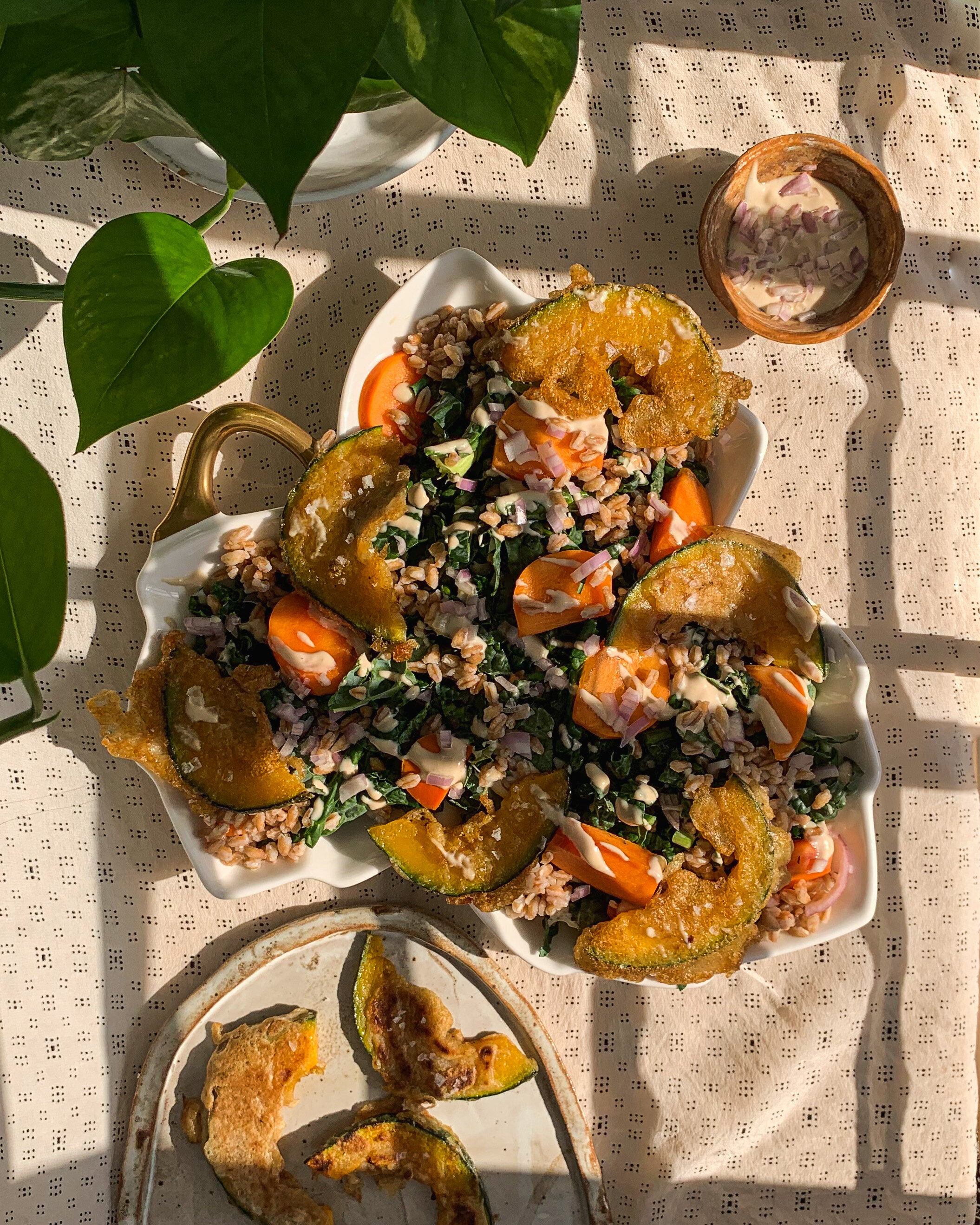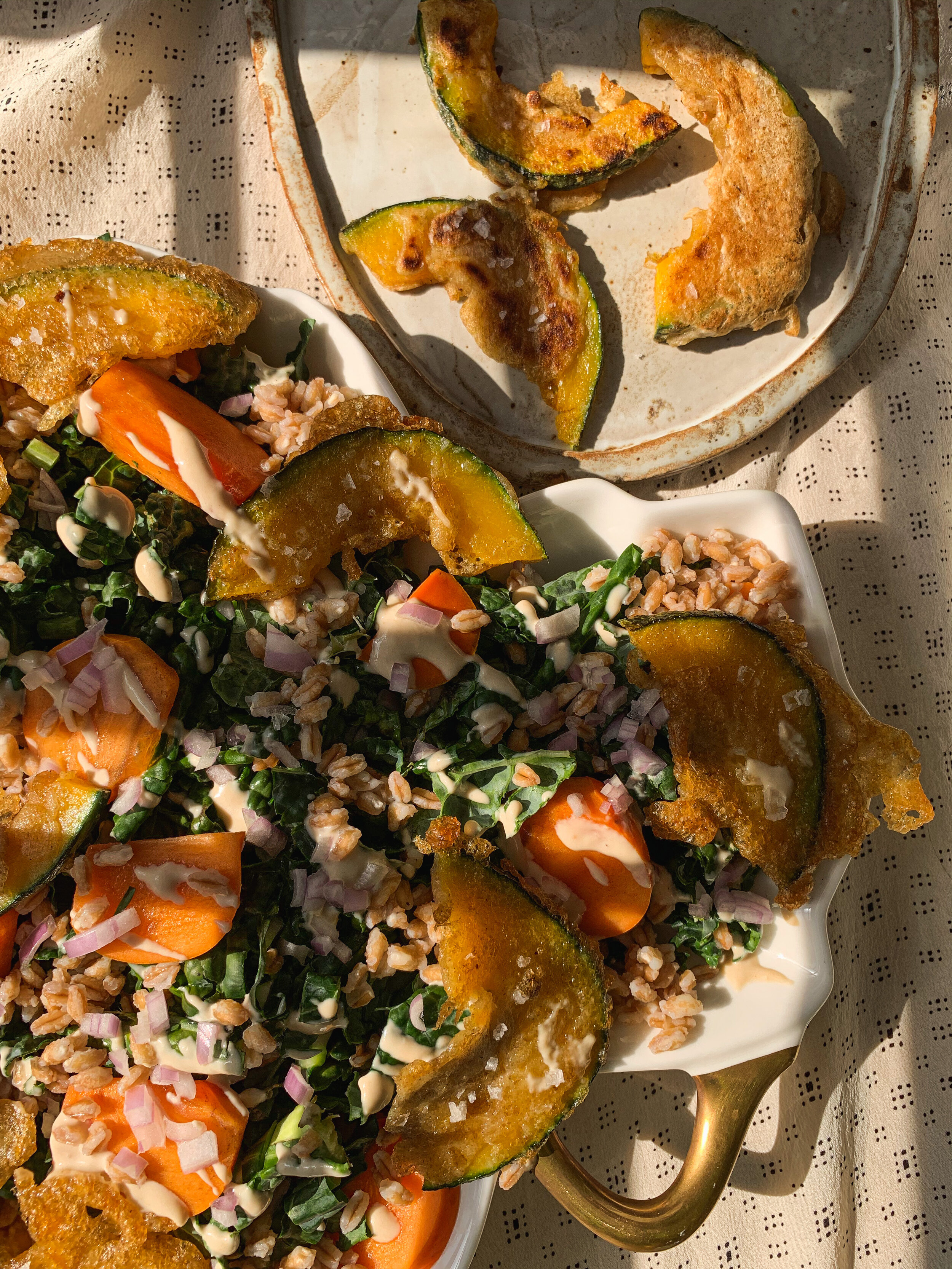kabocha tempura and kale salad
I ate this winter harvest salad five times in two weeks, and now you can too.
Servings: 2
Time: ~30 minutes
Recipe:
Salad
1 bunch tuscan kale (also called cavolo nero), chopped
2 small persimmons, sliced and skin-on
½ cup farro, cooked
Miso tahini vinegrette
1:1:1:2:3 white miso: rice wine vinegar:honey: tahini: water
(I use increments of tsp)
enough shallot, finely diced, to garnish
Kabocha sourdough tempura
0.5 lb kabocha squash (or 1/2 small kabocha squash), ⅛ inch slices
1:1 sourdough discard (unfed): ice cold water*
seasonings: sea salt, pepper, Trader Joe’s Mushroom & CompanyUmami seasoning**
pinch of baking soda
3 tbsp neutral oil
Flaky sea salt
*If no sourdough starter, substitute 1:1 all purpose flour: ice cold water and a little bit of vinegar or coat your squash in an egg wash and panko crumbs! If you do own starter, you can use day-old or weeks-old refrigerated discard. Both work.
**Trader Joes Mushroom & Company Umami seasoning is a blend of dried mushroom powders, dried thyme, onion powder, salt, black pepper, and red pepper flakes. If you don’t own this cult seasoning, just use whatever you have on hand of these listed ingredients.
1. Mix discard, ice cold water, and seasonings. At this point, the mixture will look thicker than you would like.
2. Add baking soda. The mixture will thin and froth up at this point.
3. Coat kabocha slices in batter.
4. Heat oil in pan on medium heat. Once oil is glossy, gently lay battered kabocha into pan.
Do not turn pan on high heat. High heat will fry the batter too fast and not cook through the squash. Do not overcrowd the pan.
5. Once battered edges bubble, flip. Timing will depend on the amount of oil and heat.
6. Once both sides are golden and crispy, lay on paper towel-covered plate to soak up residual oil. Sprinkle flaky salt on top immediately.
7. Mix dressing, and reserve some dressing to dip tempura kabocha.
8. Toss kale, persimmons, and farro with dressing. Add kabocha tempura slices on top.
9. Voila vegetables and grains! The salad is best enjoyed immediately when the tempura is crispy.
Non-negotiables:
Baking soda - Traditional Japanese tempura is made from egg whites, which gives the thick fried coating its lightness.
(Perhaps it is a bit of a misnomer to call this battered kabocha a tempura without the egg. I would have opted to make a more traditional style, but I’m always looking for ways to use up sourdough discard and limit food waste.)
Since I opted out off egg whites, baking soda is needed in order to lighten up the batter. Because baking soda is activated by acid (or a low pH), it will be activated by the sourdough discard. Once you add a pinch, you’ll find the batter to froth, lighten up, and thin out. Baking soda is also activated by heat, so once the batter hits the pan, it will create thin and flaky layers.
Dressing - This salad is nothing without the miso tahini dressing. The saltiness and nuttiness of miso tahini vinaigrette plays especially well with the spiced sweetness of the persimmons.
If you own a sourdough starter, I would use unfed discard instead of ripe starter. (See test #5).
Try experimenting with:
Squash - Sub any winter squash for kabocha. I chose kabocha because its my favorite and because it is a Japanese variety, it pairs well with the miso dressing.
Kale - Curly or dinosaur kale also works. (I used a curly kale in test #3)
Persimmons - Persimmons actually have a long season (September-December), so you should be able to find them during both the fall and winter. But if you can’t find them, any other crisp winter fruit will work (think: honeycrisp or fuji apple and asian or bartlett pear).
Grains - Farro is my favorite grain, and it provides a good chew to the otherwise crunchy salad. If you have to sub out farro, try brown rice.
Whole wheat flour - My starter lives on a diet of ~50:50 ap:ww flour, and I liked the tests in which I had prepared the dish with this higher amount of whole wheat. (See test #5)
If you don’t have the extra 15 minutes for the tempura, add some roasted or candied nuts (e.g., walnuts, pecans, etc.) or seeds (e.g., pumpkin seeds).
Recipe Development:
You can tell the batter is quite thick here. (What is that mysterious creature in the glass jar? A layer of Kobe the SCOBY.)
Test #1: Like most of my recipes, I never seriously intend to develop them until I get convincing feedback from a friend or family member. Prepping last minute for a little reunion picnic (thanks to the 20-something-cooking-community) with elementary school friend Arianna @dreamy.dough, I threw together a salad. I will invoke my slogan here: I’m not really sure if you can call it cooking because I just throw whatever I have in the fridge/pantry together and voila vegetables. Tuscan kale, persimmons, farro, miso vinegrette. When we pushed back our picnic 15 minutes, I realized I had a little more time to play around. I was missing a crunch factor, but keeping the salad allergen-free, I couldn’t add any nuts or seeds. With a tub of discard in the fridge, I decided to experiment with sourdough discard battered tempura—something I’ve been itching to try.
What I did right: TJ’s umami seasoning made the kabocha tempura addicting.
Needs improvement: The vinaigrette was too runny. The squash needed to be cut more uniformly so that it cooked evenly.
The consistency of the batter was a little too thin,
making the squash a bit hard to handle in the pan.
I was unhappy how this picture turned out. I wanted more light to shine through the leaves to create interesting shadows. I also wanted to feature more of the different textural components of the salad.
Test #2: My second tests are usually focused on measuring ingredients and attempting to store them in my short-term memory (because I never write anything down.) In order to thicken the dressing, I added tahini.
What I did right: Tahini thickened the dressing and added a nuanced nuttiness to the miso.
Needs improvement: The batter was still a bit too runny. I did not realize that as the baking soda aerates the batter, it further thins out the batter. So, I learned that before adding baking soda, the discard:water mixture should be thicker than I want. I also forgot to cook farro, and the chew of the salad took a downgrade.
Test #3: I ran out of Tuscan kale, so I used regular curly kale I had in the fridge. I finally got to the right batter consistency in which the batter coated the squash evenly. With some extra batter, I tried battering and frying some kabocha seeds.
What I did right: I remembered to keep the batter’s consistency a little thicker than I want before adding baking soda. Curly kale was a good substitute.
Needs improvement: When frying, the heat was too hot, so batter fried faster than the kabocha cooked. This mistake left me with unevenly cooked kabocha slices. The kabocha was more crunchy than tender, which provided a nice bite but left me bereft of the cooked kabocha’s natural sweetness. Also, don’t batter and fry seeds: they did not cook through at all. Lastly, I forgot to salt the kabocha immediately after removing from the heat!
I like how the leaf shadows came out in these picture, but still unhappy with the plating. It needs to feature more micro-texture. I forgot the flaky salt.
Test #4: I need to stop developing multiple recipes at once, but my mind and palate refuses to stay on one track. I cooked up a 3-in-1 recipe test dinner: 1) Kabocha tempura 2) Quick Pickled Mushrooms 3) my grandmother’s Fried Tofu Cakes.
What I did right: The kabocha tempura paired well with soba noodles and shrooms. I was finally able to cook and fry the kabocha through and evenly with ⅛-inch slices.
Needs improvement: N/A—recipe ready to drop!
Killed with three recipes with one dinner!
Test #5: The recipe was ready to drop after Test #4; however, I need to take a better set of pictures. I could have used pictures from Test #3, but I was not happy with the photo’s level of detail. I wanted to capture all the different textural components of the dish—the firm persimmon slices, roughly chopped kale, crispy squash with flaky salt, farro morsels, shallot specks and ribbons of dressing. Also, because I never write anything down, I had forgotten the ratios for the dressing and needed to test it again.
Since I had to cook the dish again, I decided to play with technique in this test. I wanted to see if double coating the squash would provide more flaky layers. After the squash cooked on both sides, I ladled batter on top of the squash.
I also used ripe starter instead of discard. I was playing with my newly reconstituted dehydrated starter (from my sourdough starter fundraiser!), and this starter was instead fed 90:10 ap:ww (different than my usual 50:50 ap/ww discard).
What I did right: Using 1 teaspoon increments, I was able to get the dressing to the right consistency: it coated the kale, and once tossed, it did not all sink to the bottom of the dish.
Don’t do this: The twice-coated and twice-fried kabocha tempura did not provide more flaky layers. The second layer was soft and chewy, masking the original crisp layer. Perhaps this technique did not work because I cooked the second layer in the scant residual oil from the first layer. It might have worked if I added more oil the second time around. I like the single thin fried coating though as it lets the kabocha’s own honeyed flavor shine.
While using ripe starter worked, I think the recipe worked better with discard. It was harder to dissolve the strong, gluten-ous, ripe starter in the water. Because it did not contain as much lactic acid, it did not have as strong as a reaction with the baking soda. Compared to previous tests, the starter I used this time contained a higher amount of all-purpose flour. To no one’s surprise, I liked the greater amount of whole wheat in the past tests better. The whole wheat gave more of a golden color, and the brownish flecks were much more visually appealing. Taste-wise, I also preferred the more complex flavors that the whole grains gave the coating.
If you decide to test this winter salad, please tag me @everythingalexcooks,
(and I mean actually tag me, the new IG update doesn’t notify me when I simply get mentioned in a caption).
I want to see your creations and hear your thoughts!







